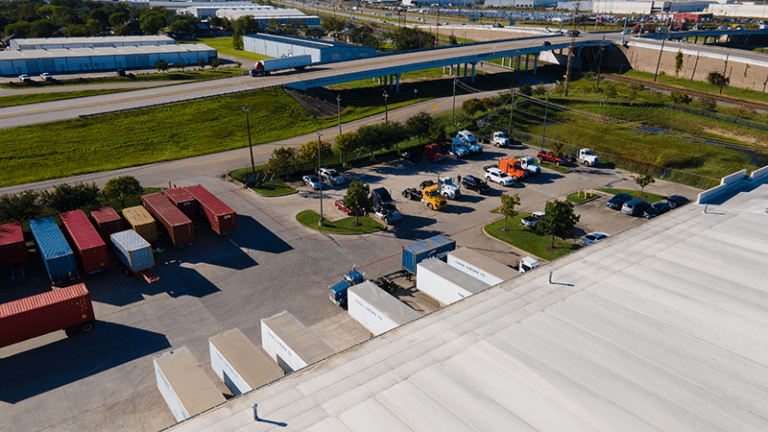Intermodal drayage is a type of transportation service that uses more than one mode of transportation to move goods over short distances.
This can include trucking, railroads, or ships, depending on the origin and destination of the shipment. This method allows companies to transport their goods over shorter distances at lower costs than traditional methods such as air freight or ocean shipping.
It’s often referred to as “multi-modal” or “intermodal” transport and can be used for both domestic and international shipping.
By utilizing intermodal transport, businesses can save money by avoiding having to pay for additional container switching or port fees.
Intermodal transport also allows for more efficient use of resources since it reduces the time needed to move cargo from one place to another.
By combining different modes of transportation into one journey, companies can reduce costs associated with delays and lost shipments. Intermodal transport can help reduce emissions since fewer vehicles are needed on the roads due to the reduced number of trips required.
Types Of Intermodal Cargo
In addition to freight containers, other items can be shipped using intermodal drayage. These include oversized equipment such as construction machinery and large shipments of industrial parts or supplies.
Specialized trailers are often used for these types of shipments to ensure they get delivered safely and on time. Many companies also utilize intermodal drayage services to deliver smaller items, such as pallets or drums, quickly and efficiently.
With the wide range of options available for shipping cargo through intermodal transport, it’s no wonder why this method has become so popular in recent years. Companies have seen significant cost savings while ensuring their shipments make it to their destination quickly and securely.
Benefits Of Drayage
Intermodal drayage offers many distinct benefits, making it an attractive business option.
Cost Savings
Drayage services provide customers a cost-effective way to move their goods from one point to another, as they don’t have to purchase additional equipment or hire more personnel.
Efficient
This type of transportation involves fewer stops and shorter turnaround times than other forms of transportation, which can help businesses stay competitive in the marketplace.
Reliable and Secure
Companies can trust that their goods arrive safely at their destination without any difficulty.
Easy Schedule
Scheduling is also much more manageable with intermodal drayage, as companies can book the service online and have their goods delivered directly to their destination without worrying about coordinating multiple shipments or dealing with various carriers.
Most drayage providers offer tracking capabilities so customers can easily keep tabs on the progress of their shipment throughout its journey. This will help customers know their goods are safe and secure during transit.
Challenges In Intermodal Logistics
Despite the many benefits of intermodal drayage, there are also some challenges that come with it.
Complexity
One of them is the complexity of planning and executing an efficient logistics strategy. Intermodal transport requires careful coordination among multiple partners, including shippers, carriers, railroads, and truckers, since each partner has its own requirements and objectives.
In addition, managing regulatory compliance across borders can be challenging due to different countries’ regulations and documentation requirements.
Cost
Although drayage services may offer lower-cost options for shipping goods over long distances, they often require more upfront costs for equipment, personnel training, and other resources.
Even though savings can offset this in fuel consumption and vehicle maintenance over time, it may still take some time before these savings are realized.
Risk of Delays
Due to weather or other unexpected events that could disrupt the delivery schedule or cause costly delays in transit times.
Additionally, intermodal transport often involves several different modes of transportation, which means that shipments must be handled multiple times during transit—increasing the chances for potential damages or mishandling along the way.
Regulations for Intermodal Shipping
These regulations governing intermodal shipping cover various aspects, including safety standards, rates, and routes.
The safety standards associated with intermodal shipping require that drivers and equipment meet specific criteria to transport hazardous materials or heavy loads.
Intermodal carriers must be registered with the Federal Motor Carrier Safety Administration (FMCSA). They must comply with federal regulations regarding driver qualifications, service hours, drug testing, vehicle maintenance, and inspection records.
All cargo must be adequately secured to prevent any accidents or damage during transport.
Rates for intermodal shipping services depend on the distance traveled, size of shipment, and type of cargo being shipped.
Companies typically charge a flat rate per mile plus additional fees for fuel surcharges, accessorial charges, and other related costs. They sometimes offer discounts based on volume or loyalty programs.
Routes must also be considered when transporting goods via intermodal services.
Drivers must be aware of any restrictions, such as weight limits on bridges or tunnels and any hazardous materials restrictions along their route, before picking up or delivering shipments.
Cost Considerations for Intermodal Drayage
These costs include fuel, labor, equipment and maintenance, insurance, and storage fees.
Fuel Cost
Fuel costs are a significant factor in the overall cost of intermodal drayage.
This is because the trucks used for intermodal drayage travel longer distances than traditional trucking operations, which requires more fuel consumption.
Some companies must pay for higher-grade fuels when using particular types of freight carriers or containers for their intermodal shipments.
Labor Cost
Drivers often require specialized training to handle intermodal containers safely, and they may also be required to work nights or weekends in order to keep up with demand.
Some companies pay drivers additional wages during peak shipping seasons or if they are hauling hazardous materials.
Equipment and Maintenance Cost
This can vary widely depending on the type of container being used and how frequently it needs repairs or upgrades.
For example, refrigerated containers generally require more frequent maintenance than standard containers due to their sensitive nature.
Insurance costs can also add up quickly depending on the type of cargo being hauled and any potential liability issues that may arise during transit.
Companies also pay storage fees when their containers remain at ports for extended periods of time before being picked up by a carrier truck.
Intermodal Drayage with Canal Cartage
It’s essential for businesses to assess their needs and explore all options before deciding which freight transport method is best for them.
With the right strategies in place, intermodal drayage can be used as an effective tool to lower transportation costs while ensuring the safe delivery of goods.
Learn more about our intermodal drayage service at Canal Cartage by calling (713) 672-1779.



